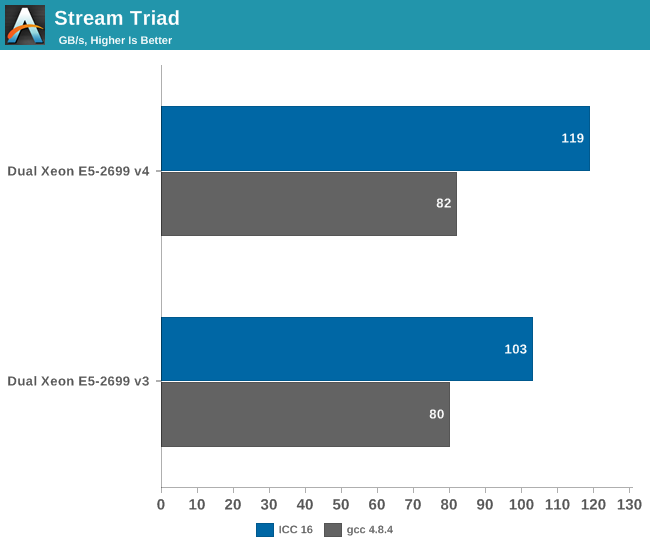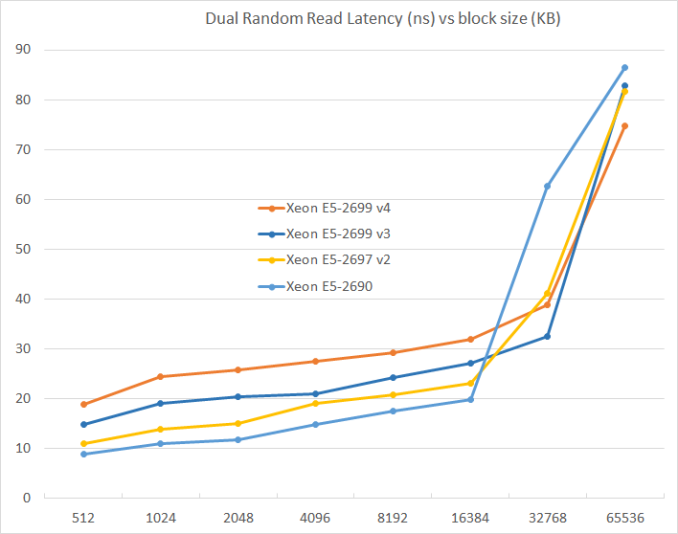The Intel Xeon E5 v4 Review: Testing Broadwell-EP With Demanding Server Workloads
by Johan De Gelas on March 31, 2016 12:30 PM EST- Posted in
- CPUs
- Intel
- Xeon
- Enterprise
- Enterprise CPUs
- Broadwell
Memory Subsystem: Bandwidth
For this review we completely overhauled our testing of John McCalpin's Stream bandwidth benchmark. We compiled the stream 5.10 source code with the Intel compiler for linux version 16 or gcc 4.8.4, both 64 bit. The following compiler switches were used on icc:
-fast -openmp -parallel
The results are expressed in GB per second. The following compiler switches were used on gcc:
-O3 –fopenmp –static
Stream allows us to estimate the maximum performance increase that DDR-2400 (Xeon E5 v4) can offer over DDR-2133 (Xeon E5 v3).

The Xeon E5 v4 with DDR4-2400 delivers about 15% higher performance then the v3 when we compile Stream with icc. To put this into perspective: DDR-4 @ 1600 delivered 80 GB/s.
The difference between DDR-4 2400 and DDR-4 2133 is negligible with gcc.
Memory Subsystem: Latency
To measure latency, we use the open source TinyMemBench benchmark. The source was compiled for x86 with gcc 4.8.2 and optimization was set to "-O2". The measurement is described well by the manual of TinyMemBench:
Average time is measured for random memory accesses in the buffers of different sizes. The larger the buffer, the more significant the relative contributions of TLB, L1/L2 cache misses, and DRAM accesses become. All the numbers represent extra time, which needs to be added to L1 cache latency (4 cycles).
We tested with dual random read, as we wanted to see how the memory system coped with multiple read requests.
The larger the L3 caches get, the higher the latency. Latency has almost doubled from the Xeon E5 v1 to the Xeon E5 v4 while capacity has almost tripled (55 MB vs 20 MB). Still, this will result in a small performance hit in many non-virtualized applications that do no need such a large L3.











112 Comments
View All Comments
isrv - Sunday, April 3, 2016 - link
i will belive that only after one by one comparison E5-1630v3 vs any of E5v4 composing wordpress front page for example.and so far, that's only a words about better caching etc...
simplyfabio - Monday, April 4, 2016 - link
Could I ask one thing here? For a Workstation 3D, both for rendering and graphic/cad, (like illustrator, photoshop, autocad, 3dsmax), could be better have more core like the E5 2690 (considering all the turbo clock speed for each core active) ore better frequency, like the 1680? Thanks a lot to everyone, I can't find a nice review on this side of this CPUs...grantdesrosiers - Monday, April 4, 2016 - link
Not sure if anyone has pointed it out yet, but I think there is an error on the "Multi-Threaded Integer Performance" page, first graph. The 2695v4 says 22 cores, I believe it should be 18.SanX - Monday, April 4, 2016 - link
Poor Moore's law for workstations... 10-20% gain per 2-years generation.Think about it: there is no reason to upgrade for the next *** 5-10 generations *** or the next 10-20 years (!!!) when the processors will be only e-fold (2.71x) faster.
dragonsqrrl - Monday, April 4, 2016 - link
The problem is your first assumption is already false.Khenglish - Monday, April 4, 2016 - link
I can't understand why the 4C and under turbo speeds are so slow on the v4 2699. A Broadwell with 55MB of cache being outperformed by a stock clocked Sandy Bridge is ridiculous. Why would this CPU not clock up to at least 4.2GHz with a 4 core workload, and say 4.4GHz for a 1 core workload? Hell it costs over $4000 and a massive TDP. You'd think Intel could take a minute to make the low core count speeds not terribly low.My workstation in my lab has a 1650 v3. My workloads peak between 4-8 cores. There is not a single CPU in the v4 lineup that would be an upgrade over the 1650 v3 despite the major power savings of 14nm and the cache size increase due to Intel's inability to set reasonable 8C and under frequencies.
Romulous - Monday, April 4, 2016 - link
People who are serious about recompiling the same software often would probably use ccache and maybe even distcc. So your Linux kernel compile test is really only there for to show potential cpu performance.LHL2500 - Tuesday, April 5, 2016 - link
"It finds a home in the same LGA 2011-3 socket."Not according to Intel's website.
http://ark.intel.com/compare/91754,81908
In this comparison between a v3 and a v4 version of a E5-2680, the socket support for the two chips are different. The older version using the the FCLGA2011-3 and the newer version using FCLGA2011.
So who is right? Anandtech or Intel?
And it not just this chip. It's all the v4s.
While I hope it's a typo on Intel's behalf, for now it doesn't look like the v4s are direct upgrades to the v3s. You will apparently need new motherboards.
xrror - Tuesday, April 5, 2016 - link
That... is a bit disconcerting. I also like how "VID Voltage Range" for the v4 parts is simply listed as "0" ...SeanJ76 - Tuesday, April 5, 2016 - link
My School had the 3rd Generation Xeon's in their Workstations, they were slow as fuck@3.3ghz!! The consumer i7 4790K/6700K would run laps around these Xeon crap cpus!